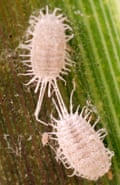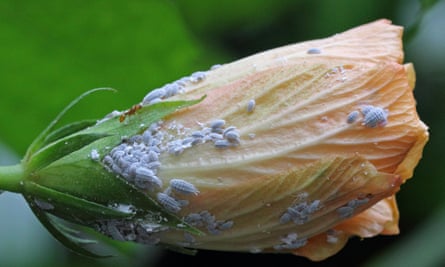My winter houseguests – the citrus trees, chillies and numerous other tender things that have to come in from the cold – have snuck in some unwanted extras: aphids and mealybugs.
Winter is often rife with indoor pests; the natural predators, ladybird and hoverfly larvae that might find their way in through an open window in summer, are deep in winter slumber, and the central heating makes for boomtown for small suckers.

Aphids are familiar, tiny sap-sucking green insects, but mealybugs are easier to miss: they are rather good at pretending to be bits of fluff. That is until your whole plant is covered in fluff and turning pale.
When young mealybugs are orange they look much like other soft-scale insects, but the adults are wildly different. The males look like tiny, dark wasps and are frankly hard to spot; and the females produce a white, woolly meal to protect themselves and their eggs from drying out. You often find them in the axis of stems and leaf joints. They excrete a sticky substance that attracts sooty moulds (as the name suggests, the leaf looks as if it has been dusted in soot). At this point the plant really begins to suffer.
There are several solutions. Soap suds will asphyxiate the breathing holes of the insects, so wash plants down with diluted horticultural soft soap. You might find it easiest to take the plant to the bath to do this: you’ll need to get the solution into all the nooks and crannies. Be prepared to do it repeatedly; they are very good at hiding.

Alternatively, dab the mealybug with vodka using a paint brush to strip it of its protective waxy layer and dry it out – a useful trick if you spot the problem early. However, my favourite solution is SB Invigorator. Widely used in the trade, it’s a blend of biodegradable, non-toxic fatty acids, surfactants, algae and nutrients. It is both a pesticide, a mildewcide and, because of its nutrients, a foliar feed. It can be used on edible crops, is safe for children and pets, and is incredibly effective.
Spray both above and below the leaf at two-day intervals until the pests are gone. It’s good for aphids, mealybugs, whitefly, scale, woolly aphids and powdery mildews. Of course, what kills a pest, would also kill a ladybird, so it’s ideal to use now when these natural predators aren’t about. However, if you are using biological controls, such as Cryptolaemus larvae or parasites, use the plant invigorator first to kill off as many pests as possible and wait a couple of days before introducing your natural predators.

Comments (…)
Sign in or create your Guardian account to join the discussion